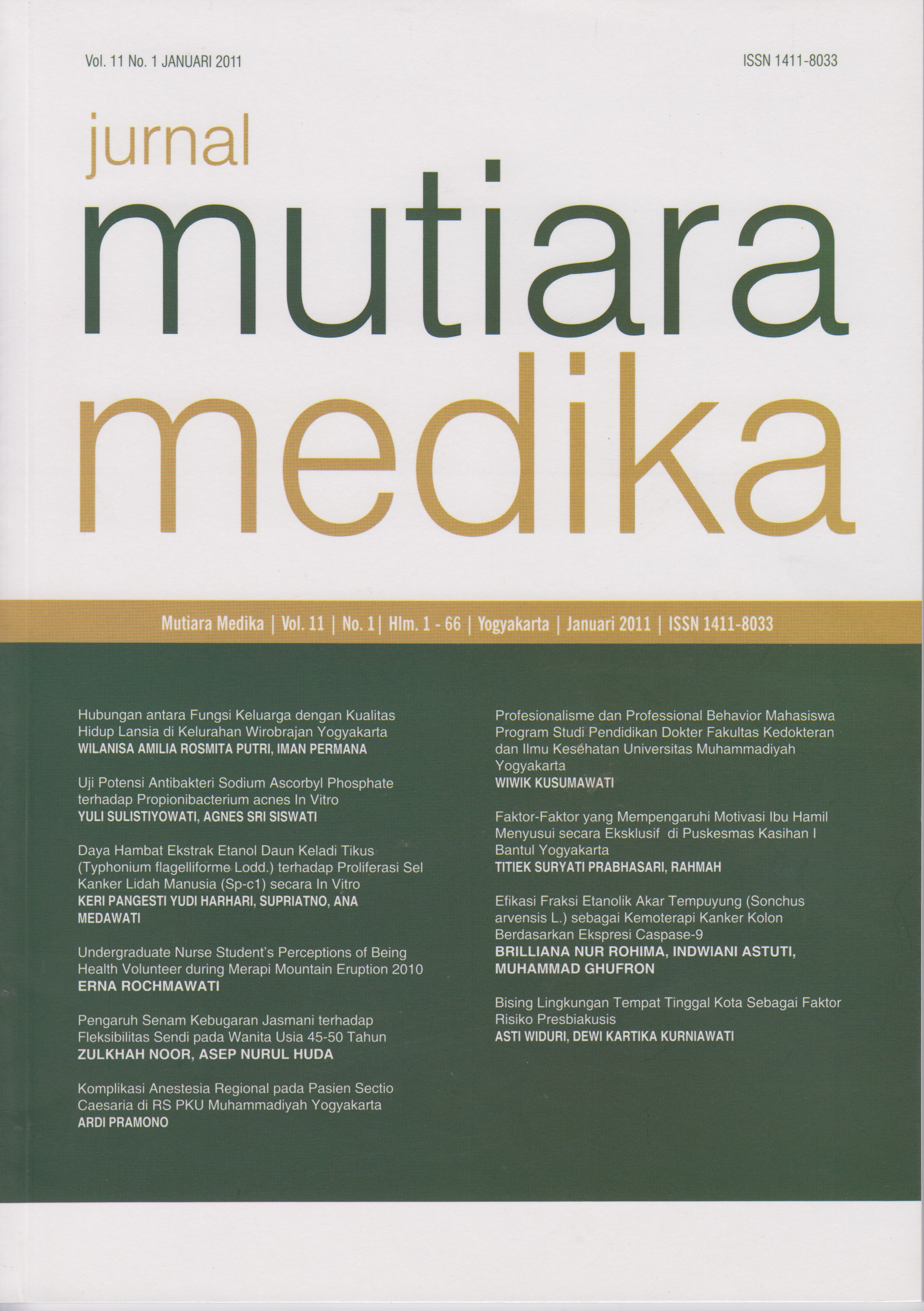Daya Hambat Ekstrak Etanol Daun Keladi Tikus (Typhonium flagelliforme Lodd.) terhadap Proliferasi Sel Kanker Lidah Manusia (Sp-c1) secara In Vitro
DOI:
https://doi.org/10.18196/mmjkk.v11i1.922Keywords:
Typhonium flagelliforme Lodd., proliferasi, sel kanker lidah (SP-C1), MTT assayAbstract
Keladi tikus (Typhonium flagelliforme Lodd.) merupakan tanaman yang telah banyak digunakan sebagai obat tradisional oleh masyarakat Indonesia. Keladi tikus memiliki zat aktif antikanker dalam bentuk triterpenoid, alkaloid, polifenol, Ribosome Inactivating Protein (RIP) dan fitol. Penelitian ini bertujuan untuk menguji daya hambat ekstrak etanol daun keladi tikus terhadap proliferasi sel kanker lidah manusia ( SP-C1). Desain penelitian ini adalah eksperimental laboratoris murni. Penelitian ini menggunakan biakan sel kanker lidah (SP-C1) yang diinkubasikan dengan ekstrak etanol daun keladi tikus berbagai konsentrasi (25 , 50, 75, 100, 125 µg/ml) dengan waktu paparan 24 dan 48 jam, sebagai kontrol negatif digunakan biakan sel dalam media Rosswell Park Memorial Institute 1640 (RPMI-1640). Uji aktivitas sitotoksik dilakukan dengan metode MTT assay. Pemberian ekstrak etanol daun keladi tikus cenderung menurunkan jumlah sel kanker lidah (SP-C1). Potensi hambatan proliferasi tertinggi ekstrak etanol daun keladi tikus terjadi pada konsentrasi 125 µg/ml yang menghambat proliferasi sel kanker lidah (SP-C1) sebesar 59% selama waktu 24 jam inkubasi dan sebesar 73% selama 48 jam inkubasi. Disimpulkan bahwa ekstrak etanol daun keladi tikus dapat menghambat proliferasi sel kanker lidah manusia (SP-C1).
References
Sudiono J. Pemeriksaan Patologi untuk Diagnosis Neoplasma Mulut. Penerbit Buku Kedokteran: EGC, Jakarta, 2008.
Sudewo B. Tanaman Obat Populer Penggempur Aneka Penyakit. Jakarta: Agromedia Pustaka; 2007.
Mangan Y. Solusi Sehat Mencegah dan Mengatasi Kanker. PT. AgroMedia Pustaka, Jakarta, 2009.p.44-45.
Mudahar H, Widowati L, Sundari D. Uji Aktivitas Ekstrak Etanol 50% Umbi Keladi Tikus (Typhonium flagelliforme) terhadap Sel Kanker Payudara (MCF-7 Cell Line) secara In Vitro.
Puslitbang Biomedis dan Farmasi, Badan Penelitian dan Pengembangan Kesehatan; 2006.
Choon SL, Mas R, Nair NK, Majid MIA, Mansor, Navaratnam. Typhonium flagelliforme Inhibits Cancer Cell Growth In Vitro and Induces Apoptosis: An Evaluation by The Bioactivity Guided Approach. J of Enthophar 2008;118; 14-20.
Permadi A, Membuat Kebun Tanaman Obat. Jakarta: Pustaka Bunda, Anggota Ikapi; 2008. p.31-32.
Velde V, Bosman F, Wargener D. Onkologi. Rev ed. Yogyakarta: Panitia Kanker RSUP Dr. Sardjito; 1999.
Tambunan GW. Diagnosis dan Tatalaksana Sepuluh Jenis Kanker Terbanyak di Indonesia. Jakarta: EGC; 1991.
Supriatno, Yuletnawati SE. Aktivitas Antikanker Cepharantine pada Kanker Lidah Manusia In Vitro (Tinjauan Proliferasi, Invasi dan Metastasis Sel). Majalah Kedokteran Gigi 2006; 13(2): 141-145.
Yuhono. Keladi Tikus (Typhonium flagelliforme, Lodd) Tanaman Obat yang Berpeluang Menyembuhkan Kanker. Warta Penelitian dan Pengembangan Pertanian 2007;13(1)
Mizushina Y, Iida A, Ohta K, Sugawara F, Sakaguchi K. Novel Triterpenoids Inhibits both DNA Polymerase and DNA Topoisomerase. Biochemical J 2000;350:757-763.
Andoh T. DNA Topoisomerases in Cancer Therapy: Present and Future. New York:
Klower Academic; 2003.p.15-16.
Alberts B. Bray D. Johnson A. Lewis J. Raff M. Roberts K, Essential Cell Biology: An Introduction to The Molecular Biology of The Cell. New York: Garland Publising; 1998.p.193.
Abdurashidova G, Radulescu S, Sandoval O, Zarariev S, Danailov M, Demidovich A, et al. Functional Interactions of DNA Topoisomerases with A Human Replication Origin. The EMBO J 2007;26:998-1009.
Sudjadi, Witasari L, Sadarum MT, Nastity N, Sismindari, Efek Sitotoksik suatu Protein seperti Ribosome Inactivating Proteins yang bersifat Asam dari daun Mirabilis jalapa L. pada Sel Kanker. Majalah Farmasi Indonesia 2007; 18(1);8-14.
Mackie JT, Atshaves B, Payne HR, McIntosh A, Schroeder F, Kier B. Phytol-induced Hepatoxicity in Mice. Toxicol Pathol 2009; 000:1-8.
Downloads
Published
Issue
Section
License
Copyright
Authors retain copyright and grant Mutiara Medika: Jurnal Kedokteran dan Kesehatan (MMJKK) the right of first publication with the work simultaneously licensed under an Attribution 4.0 International (CC BY 4.0) that allows others to remix, adapt and build upon the work with an acknowledgment of the work's authorship and of the initial publication in Mutiara Medika: Jurnal Kedokteran dan Kesehatan (MMJKK).
Authors are permitted to copy and redistribute the journal's published version of the work (e.g., post it to an institutional repository or publish it in a book), with an acknowledgment of its initial publication in Mutiara Medika: Jurnal Kedokteran dan Kesehatan (MMJKK).
License
Articles published in the Mutiara Medika: Jurnal Kedokteran dan Kesehatan (MMJKK) are licensed under an Attribution 4.0 International (CC BY 4.0) license. You are free to:
- Share — copy and redistribute the material in any medium or format.
- Adapt — remix, transform, and build upon the material for any purpose, even commercially.
This license is acceptable for Free Cultural Works. The licensor cannot revoke these freedoms as long as you follow the license terms. Under the following terms:
Attribution — You must give appropriate credit, provide a link to the license, and indicate if changes were made. You may do so in any reasonable manner, but not in any way that suggests the licensor endorses you or your use.
- No additional restrictions — You may not apply legal terms or technological measures that legally restrict others from doing anything the license permits.






